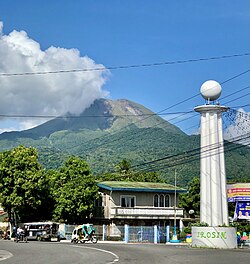Irosin | |
|---|---|
| Municipality of Irosin | |
 Irosin Beacon with Mount Bulusan in the background | |
 Map of Sorsogon with Irosin highlighted | |
 Interactive map of Irosin | |
Location within the Philippines | |
| Coordinates: 12°42′18″N124°01′55″E / 12.705°N 124.0319°E | |
| Country | Philippines |
| Region | Bicol Region |
| Province | Sorsogon |
| District | 2nd district |
| Barangays | 28 (see Barangays) |
| Government | |
| • Type | Sangguniang Bayan |
| • Mayor | Alfredo J. Cielo Jr. |
| • Vice Mayor | Christian D. Lim |
| • Representative | Manuel L. Fortes Jr. |
| • Municipal Council | Members |
| • Electorate | 41,494 voters (2025) |
| Area | |
• Total | 149.87 km2 (57.87 sq mi) |
| Elevation | 168 m (551 ft) |
| Highest elevation | 791 m (2,595 ft) |
| Lowest elevation | 20 m (66 ft) |
| Population (2024 census) [3] | |
• Total | 59,540 |
| • Density | 397.3/km2 (1,029/sq mi) |
| • Households | 12,753 |
| Economy | |
| • Income class | 2nd municipal income class |
| • Poverty incidence | 26.41 |
| • Revenue | ₱ 312.5 million (2022) |
| • Assets | ₱ 609.6 million (2022) |
| • Expenditure | ₱ 275.9 million (2022) |
| • Liabilities | ₱ 272 million (2022) |
| Service provider | |
| • Electricity | Sorsogon 1 Electric Cooperative (SORECO 1) |
| Time zone | UTC+8 (PST) |
| ZIP code | 4707 |
| PSGC | |
| IDD : area code | +63 (0)56 |
| Native languages | Sorsogon language Tagalog |
| Website | www |
Irosin, officially the Municipality of Irosin (Southern Sorsoganon : Bungto san Irosin; Waray : Bungto han Irosin, Tagalog : Bayan ng Irosin), is a municipality in the province of Sorsogon, Philippines. According to the 2024 census, it has a population of 59,540 people. [5]

